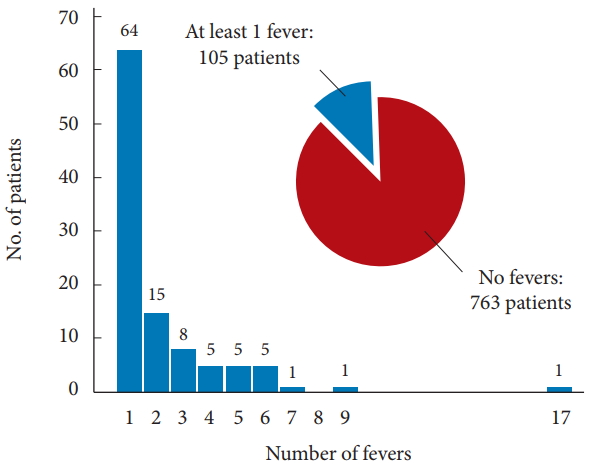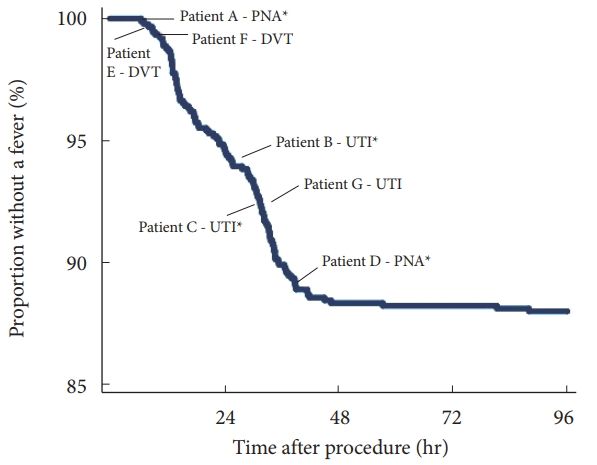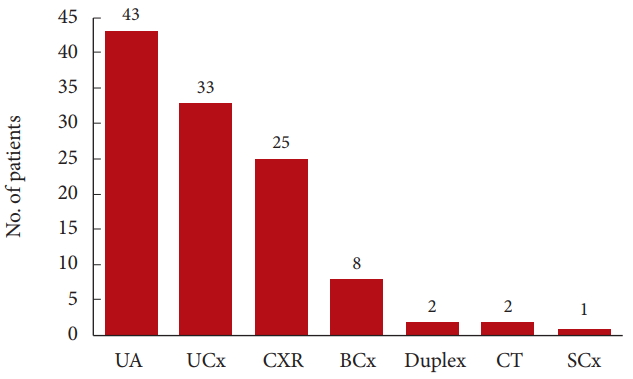1. Angel JD, Blasier RD, Allison R. Postoperative fever in pediatric orthopaedic patients. J Pediatr Orthop 1994 14:799-801.


2. Athanassious C, Samad A, Avery A, et al. Evaluation of fever in the immediate postoperative period in patients who underwent total joint arthroplasty. J Arthroplasty 2011 26:1404-8.


3. Uçkay I, Agostinho A, Stern R, et al. Occurrence of fever in the first postoperative week does not help to diagnose infection in clean orthopaedic surgery. Int Orthop 2011 35:1257-60.


4. Czaplicki AP, Borger JE, Politi JR, et al. Evaluation of postoperative fever and leukocytosis in patients after total hip and knee arthroplasty. J Arthroplasty 2011 26:1387-9.


5. Lesperance R, Lehman R, Lesperance K, et al. Early postoperative fever and the "routine" fever work-up: results of a prospective study. J Surg Res 2011 171:245-50.


6. Guinn S, Castro FP Jr, Garcia R, et al. Fever following total knee arthroplasty. Am J Knee Surg 1999 12:161-4.

7. Kenan S, Liebergall M, Simchen E, et al. Fever following orthopedic operations in children. J Pediatr Orthop 1986 6:139-42.


8. Kennedy JG, Rodgers WB, Zurakowski D, et al. Pyrexia after total knee replacement. A cause for concern? Am J Orthop (Belle Mead NJ) 1997 26:549-52, 554.

9. Shaw JA, Chung R. Febrile response after knee and hip arthroplasty. Clin Orthop Relat Res 1999;(367):181-9.
10. Ballestas HC. Postoperative fever: to what is the body really responding? AORN J 2007 86:983-8.


11. Andres BM, Taub DD, Gurkan I, et al. Postoperative fever after total knee arthroplasty: the role of cytokines. Clin Orthop Relat Res 2003 415:221-31.

12. Ward DT, Hansen EN, Takemoto SK, et al. Cost and effectiveness of postoperative fever diagnostic evaluation in total joint arthroplasty patients. J Arthroplasty 2010 25(6 Suppl):43-8.


13. Fanning J, Brewer J. Delay of hospital discharge secondary to postoperative fever--is it necessary? J Am Osteopath Assoc 2002 102:660-1.

15. Badillo AT, Sarani B, Evans SR. Optimizing the use of blood cultures in the febrile postoperative patient. J Am Coll Surg 2002 194:477-87.


16. de la Torre SH, Mandel L, Goff BA. Evaluation of postoperative fever: usefulness and cost-effectiveness of routine workup. Am J Obstet Gynecol 2003 188:1642-7.


17. Schey D, Salom EM, Papadia A, et al. Extensive fever workup produces low yield in determining infectious etiology. Am J Obstet Gynecol 2005 192:1729-34.


19. Anderson JT, Osland JD. Blood cultures for evaluation of fever after total joint arthroplasty. Am J Orthop (Belle Mead NJ) 2009 38:E134-6.

20. Bindelglass DF, Pellegrino J. The role of blood cultures in the acute evaluation of postoperative fever in arthroplasty patients. J Arthroplasty 2007 22:701-2.


21. Tai TW, Chang CW, Lin CJ, et al. Elevated temperature trends after total knee arthroplasty. Orthopedics 2009 32:886.


22. Blumstein GW, Andras LM, Seehausen DA, et al. Fever is common postoperatively following posterior spinal fusion: infection is an uncommon cause. J Pediatr 2015 166:751-5.


23. Seo J, Park JH, Song EH, et al. Postoperative nonpathologic fever after spinal surgery: incidence and risk factor analysis. World Neurosurg 2017 103:78-83.


25. Charlson ME, Pompei P, Ales KL, et al. A new method of classifying prognostic comorbidity in longitudinal studies: development and validation. J Chronic Dis 1987 40:373-83.


26. Narayan M, Medinilla SP. Fever in the postoperative patient. Emerg Med Clin North Am 2013 31:1045-58.


27. Frank SM, Kluger MJ, Kunkel SL. Elevated thermostatic setpoint in postoperative patients. Anesthesiology 2000 93:1426-31.


28. Miyawaki T, Maeda S, Koyama Y, et al. Elevation of plasma interleukin-6 level is involved in postoperative fever following major oral and maxillofacial surgery. Oral Surg Oral Med Oral Pathol Oral Radiol Endod 1998 85:146-52.


29. Buvanendran A, Kroin JS, Tuman KJ, et al. Effects of perioperative administration of a selective cyclooxygenase 2 inhibitor on pain management and recovery of function after knee replacement: a randomized controlled trial. JAMA 2003 290:2411-8.


30. Lu X, Jin J, Lin J, et al. Course of fever and potential infection after total joint replacement. Knee Surg Sports Traumatol Arthrosc 2015 23:1870-6.


31. Engoren M. Lack of association between atelectasis and fever. Chest 1995 107:81-4.


33. Carreon LY, Puno RM, Dimar JR 2nd, et al. Perioperative complications of posterior lumbar decompression and arthrodesis in older adults. J Bone Joint Surg Am 2003;85-A:2089-92.
34. Maoz G, Phillips M, Bosco J, et al. The Otto Aufranc Award: modifiable versus nonmodifiable risk factors for infection after hip arthroplasty. Clin Orthop Relat Res 2015 473:453-9.


36. Shi C, Yang C, Gao R, et al. Risk factors for delirium after spinal surgery: a meta-analysis. World Neurosurg 2015 84:1466-72.


37. Siemionow K, Pelton MA, Hoskins JA, et al. Predictive factors of hospital stay in patients undergoing minimally invasive transforaminal lumbar interbody fusion and instrumentation. Spine (Phila Pa 1976) 2012 37:2046-54.


38. Willis-Owen CA, Konyves A, Martin DK. Factors affecting the incidence of infection in hip and knee replacement: an analysis of 5,277 cases. J Bone Joint Surg Br 2010 92:1128-33.


39. Beilin B, Shavit Y, Hart J, et al. Effects of anesthesia based on large versus small doses of fentanyl on natural killer cell cytotoxicity in the perioperative period. Anesth Analg 1996 82:492-7.


40. Negishi C, Lenhardt R. Fever during anaesthesia. Best Pract Res Clin Anaesthesiol 2003 17:499-517.



































